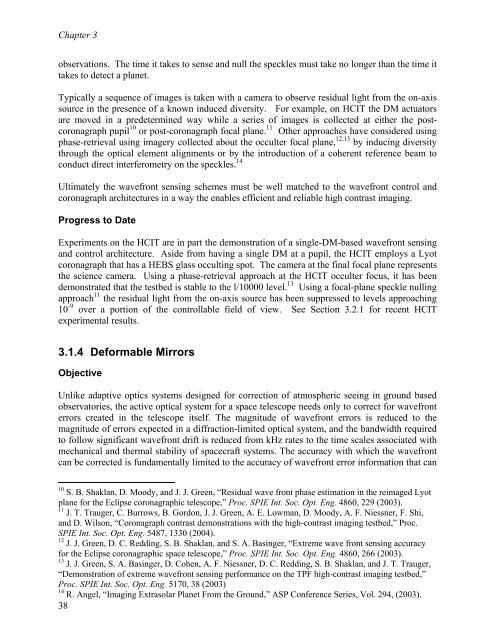TPF-C Technology Plan - Exoplanet Exploration Program - NASA
TPF-C Technology Plan - Exoplanet Exploration Program - NASA
TPF-C Technology Plan - Exoplanet Exploration Program - NASA
You also want an ePaper? Increase the reach of your titles
YUMPU automatically turns print PDFs into web optimized ePapers that Google loves.
Chapter 3<br />
observations. The time it takes to sense and null the speckles must take no longer than the time it<br />
takes to detect a planet.<br />
Typically a sequence of images is taken with a camera to observe residual light from the on-axis<br />
source in the presence of a known induced diversity. For example, on HCIT the DM actuators<br />
are moved in a predetermined way while a series of images is collected at either the postcoronagraph<br />
pupil 10 or post-coronagraph focal plane. 11 Other approaches have considered using<br />
phase-retrieval using imagery collected about the occulter focal plane, 12,13 by inducing diversity<br />
through the optical element alignments or by the introduction of a coherent reference beam to<br />
conduct direct interferometry on the speckles. 14<br />
Ultimately the wavefront sensing schemes must be well matched to the wavefront control and<br />
coronagraph architectures in a way the enables efficient and reliable high contrast imaging.<br />
Progress to Date<br />
Experiments on the HCIT are in part the demonstration of a single-DM-based wavefront sensing<br />
and control architecture. Aside from having a single DM at a pupil, the HCIT employs a Lyot<br />
coronagraph that has a HEBS glass occulting spot. The camera at the final focal plane represents<br />
the science camera. Using a phase-retrieval approach at the HCIT occulter focus, it has been<br />
demonstrated that the testbed is stable to the l/10000 level. 13 Using a focal-plane speckle nulling<br />
approach 11 the residual light from the on-axis source has been suppressed to levels approaching<br />
10 -9 over a portion of the controllable field of view. See Section 3.2.1 for recent HCIT<br />
experimental results.<br />
3.1.4 Deformable Mirrors<br />
Objective<br />
Unlike adaptive optics systems designed for correction of atmospheric seeing in ground based<br />
observatories, the active optical system for a space telescope needs only to correct for wavefront<br />
errors created in the telescope itself. The magnitude of wavefront errors is reduced to the<br />
magnitude of errors expected in a diffraction-limited optical system, and the bandwidth required<br />
to follow significant wavefront drift is reduced from kHz rates to the time scales associated with<br />
mechanical and thermal stability of spacecraft systems. The accuracy with which the wavefront<br />
can be corrected is fundamentally limited to the accuracy of wavefront error information that can<br />
10 S. B. Shaklan, D. Moody, and J. J. Green, “Residual wave front phase estimation in the reimaged Lyot<br />
plane for the Eclipse coronagraphic telescope,” Proc. SPIE Int. Soc. Opt. Eng. 4860, 229 (2003).<br />
11 J. T. Trauger, C. Burrows, B. Gordon, J. J. Green, A. E. Lowman, D. Moody, A. F. Niessner, F. Shi,<br />
and D. Wilson, “Coronagraph contrast demonstrations with the high-contrast imaging testbed,” Proc.<br />
SPIE Int. Soc. Opt. Eng. 5487, 1330 (2004).<br />
12 J. J. Green, D. C. Redding, S. B. Shaklan, and S. A. Basinger, “Extreme wave front sensing accuracy<br />
for the Eclipse coronagraphic space telescope,” Proc. SPIE Int. Soc. Opt. Eng. 4860, 266 (2003).<br />
13 J. J. Green, S. A. Basinger, D. Cohen, A. F. Niessner, D. C. Redding, S. B. Shaklan, and J. T. Trauger,<br />
“Demonstration of extreme wavefront sensing performance on the <strong>TPF</strong> high-contrast imaging testbed,”<br />
Proc. SPIE Int. Soc. Opt. Eng. 5170, 38 (2003)<br />
14 R. Angel, “Imaging Extrasolar <strong>Plan</strong>et From the Ground,” ASP Conference Series, Vol. 294, (2003).<br />
38
















